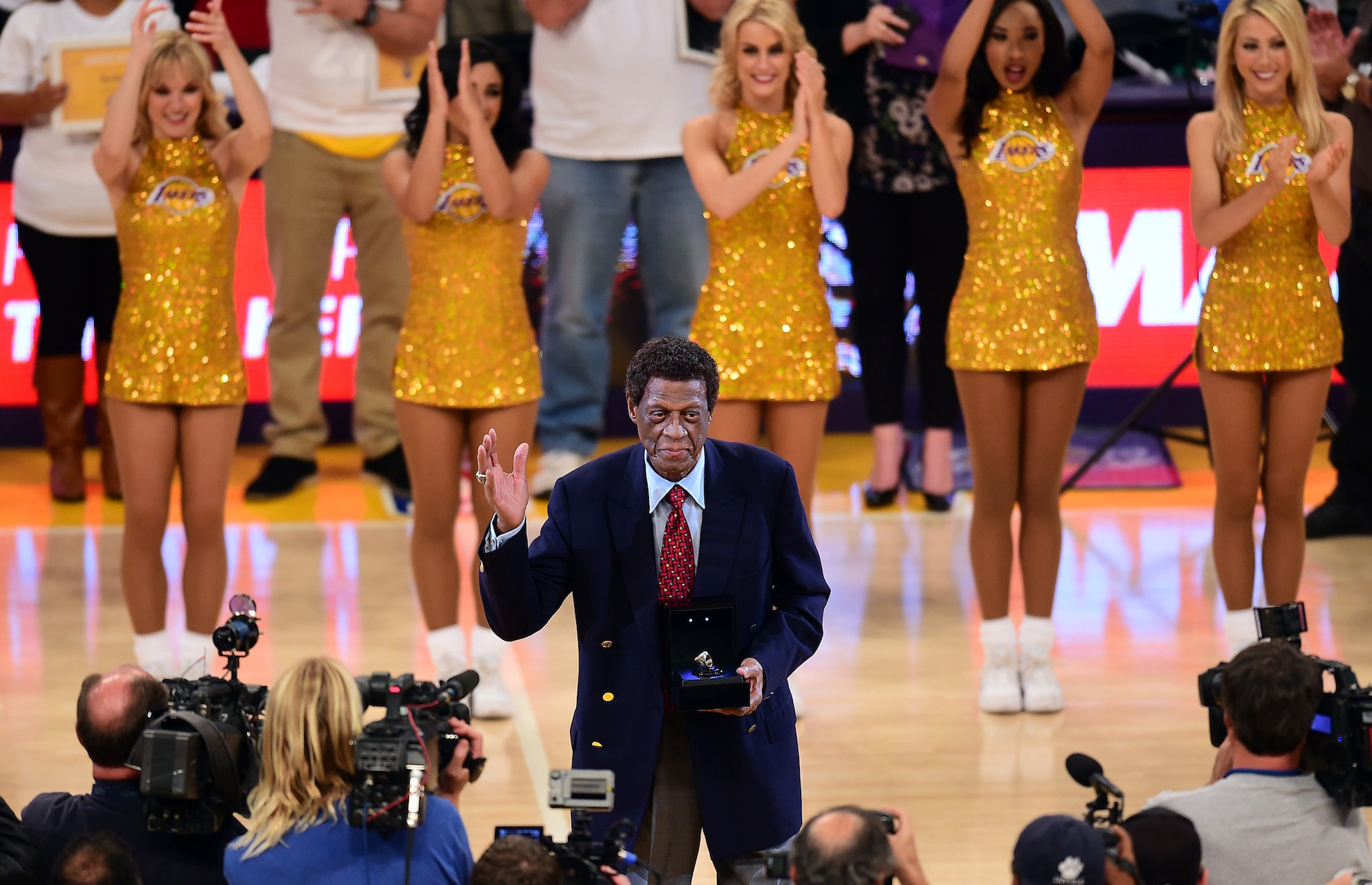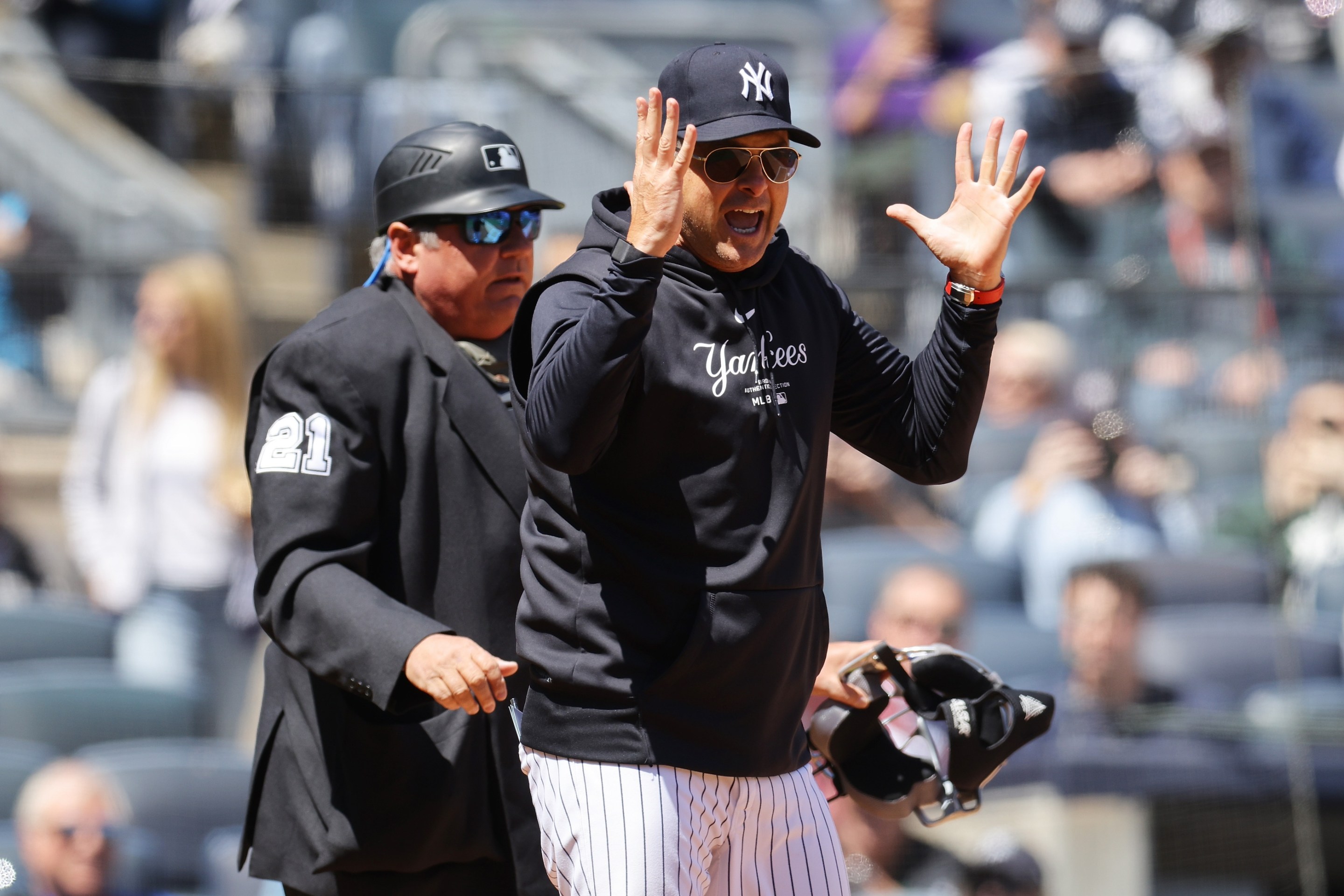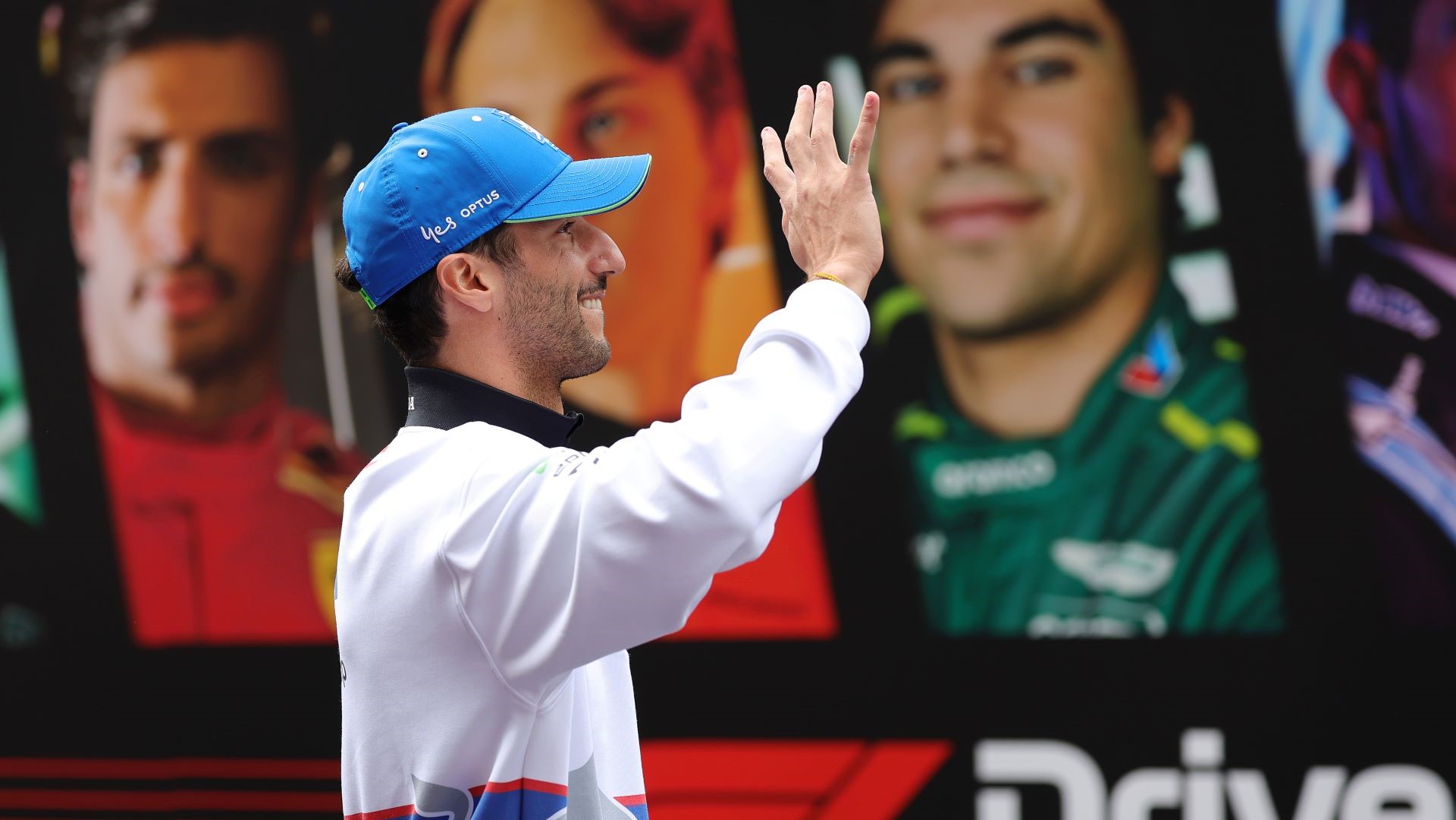The Case For Elgin Baylor High School
11:50 AM EDT on October 13, 2020

NBA legend and former Laker Elgin Baylor acknowledges the crowd upon reception of an award at halftime during the Los Angeles Lakers v Golden State Warriors NBA game at Staples Center in Los Angeles, California on November 16, 2014
Like lots of places and things named long ago for lousy people, Woodrow Wilson Senior High School, the biggest of Washington D.C.’s public schools, is losing its title. As a result, the search for a replacement has commenced in earnest.
Look no further than: Elgin Baylor High School.
I’m not objective about Elgin Baylor. I’ve written lots of stories about Baylor over the past 25 years, and every one of them argues that he’s among the greatest, most influential and most underappreciated athletes in American history. But you don’t have to be a Baylor obsessive to rate the case for Baylor High as a slam dunk. Not only because of Baylor’s biography: Plainly, he changed the way the great American game of basketball was played. But also because of what he had to overcome along the way to greatness, a path that relates to the same reasons behind Wilson’s removal from the school’s marquee.
The nutshell case for Baylor first: He’s a D.C. native and a product of the public schools. As a kid he was victimized by the segregationist systems Woodrow Wilson championed both as an academic and as president. Baylor spent his entire childhood being denied access to the city’s best parks, pools and schools simply because of the color of his skin. He went on to become the greatest homegrown purveyor of D.C.’s greatest cultural export, basketball. The game was big in the black community here before any other city: The sports programs at black schools in the District were run from 1910 to 1954 by Edwin B. Henderson, a basketball Hall of Fame member regarded as "the father of black basketball" who introduced the game to his students after picking it up while studying at Harvard.
But Baylor's renown outside D.C.'s black neighborhoods, where he was a legend as a teenager, was never what it should have been. The local white-owned media didn't give him the coverage he deserved while playing for all-black Spingarn High School in the mid-1950s. Baylor's work as a civil rights pioneer is also undervalued. In 1959, as an NBA rookie and the league's newest superstar with the Los Angeles Lakers, he became the first pro athlete to go on strike to protest racism faced by black players.
Bottom line: Baylor, now 86, is only officially celebrated in cities other than the one he came from. The Lakers erected a statue of Baylor outside the Staples Center in Los Angeles, alongside statues of fellow basketball Hall of Famers Shaq, Kobe, Kareem, Magic and Jerry West. I recently did a talk radio show about Baylor with a station in Seattle, where he played college basketball. Being a Baylor obsessive and D.C. devotee, I couldn’t help but notice there’s far more reverence for him in THAT Washington than in the Washington where he was raised. Since 2004 the Elgin Baylor Classic college basketball tournament has been held each fall in Seattle. In 2009, the floor at Key Arena was dedicated as Elgin Baylor Court.
But there’s almost nothing named for Baylor in the nation's capital. (Well, nothing other than Ginuwine, the '90s R&B crooner, a D.C. native whose real name is Elgin Baylor Lumpkin in tribute to the legendary baller.) This revelation gave me an idea: What better way to honor the great Elgin Baylor, as well as apologize in some small way while he’s still alive? What better way to give the biggest F.U. to Woodrow Wilson for the words and actions that are forcing his cancellation, than to replace Wilson’s name with Baylor’s?
As for Woodrow Wilson, the guy? Look elsewhere for what people liked enough about him to name a high school after him. I'll focus here on his manifest awfulness, which until recent years was whitewashed from his bio. The beliefs and policies he espoused are exactly what Baylor had to overcome. Let’s start with the five-book series Wilson published in 1901, "A History of the American People." The Virginia native, who grew up with a pastor father whose church relied on the labor of slaves, pitied whites living in Southern states after the Civil War and emancipation, asserting that giving freed blacks voting rights forced whites to endure the "intolerable burden of governments sustained by the votes of ignorant negroes." His books celebrated the birth of the Ku Klux Klan, which he described as a band of "frolicking comrades" that "threw the negroes into a very ecstasy of panic to see these sheeted [klan members] move near them in the shrouded night."
Wilson's deeds backed up his appalling words. As president of Princeton University, Wilson promoted segregated education. In 1904, he dismissed talk of racially integrating his school, as Harvard and Yale had already done, and boasted that "no negro has ever applied for admission" to Princeton. When a black student from South Carolina named G. McArthur Sullivan requested admission in 1909. Wilson provided written counsel that “it is altogether inadvisable for a colored man to enter Princeton.”
Even with that record, Wilson campaigned for the black electorate while running for the presidency in 1912, with some success. Such outreach convinced W.E.B. DuBois, who’d recently founded the NAACP, to ignore his trepidations and endorse Wilson, the candidate of the Democratic Party, over incumbent William Howard Taft of the then-historically less racist Republican Party, and former president Teddy Roosevelt, running as a member of a GOP splinter group calling itself the Bull Moose Party.
Wilson won in a landslide. As the first Southerner to occupy the White House since Reconstruction, he then immediately reneged on his pledge to black voters to improve their lot. Wilson rolled back any racially progressive moves made during the Taft and Roosevelt administrations. In his 1963 book, Race: The History of An Idea in America, historian Thomas Gossett says that early into his presidency Wilson fired nearly every black supervisor in the federal government, divided workplaces by race and installed “separate eating and toilet facilities” for whites and blacks in government buildings.
Wilson said he hoped workplace segregation “would prevent any kind of friction between the white employees and the Negro employees.” All applicants for federal jobs for the first time were required to submit photographs to make race-based hiring decisions easier. These policies crippled the growth of a black middle class in D.C., solidifying the segregation of its neighborhoods and schools.
Wilson was hardly a closeted bigot: In 1915, he hosted a White House screening of The Birth of a Nation, a silent movie that the NAACP protested even as it premiered for promoting the Klan and for its cartoonish depictions of blacks, notably using white actors in blackface. The feature is now known to have incited a nationwide boom in Klan membership.
America re-elected its segregationist president to a second term in 1916. Shortly after leading the American forces to a victory in World War I, dubiously dubbed the "War That Will End War" by writer H.G. Wells in 1918, Wilson suffered a massive stroke. He served out the rest of his second presidential term incapacitated and hiding from the public. He died in 1924 without ever returning to public life.
The high school that would bear Wilson's name was proposed by D.C. school board members in 1932 and, according to contemporary reports in the Washington Post, Congress appropriated $1.15 million in the federal budget for its construction a year later. The capital city has always been at the mercy of the federal government for more than money, of course: Congress, which decreed in the 1860s that all D.C. public schools be segregated by race, also deemed that the new secondary school would be exclusively for white students. The Washington Evening Star reported on January 1, 1933 that the newest high school would be "named for the war-time president at the request of virtually all the civic organizations in the general Northwest section that will be served by the school."
Princeton wouldn’t award its first undergraduate degree to a black student until 1947. Black kids were legally barred from enrolling in Wilson High School, which opened in the fall of 1935, until after the Supreme Court’s 1954 ruling in Brown v. Board of Education, which held that segregation in public education was unconstitutional. The high court's world-changing ruling came mere weeks before Baylor graduated from Spingarn, having never gone to any school with a white student, or having played a scholastic basketball game with or against a white player.
In recent years the move toward reappraisals of historic public officials has meant tributes to Wilson have been reconsidered. In 2015, students at Princeton staged a walkout and sit-in to demand the school confront the racist ways of its most glorified alum by removing his name from both the Wilson School of International Affairs and Wilson College on the New Jersey campus. Administrators coaxed the students to end their protests by promising the formation of something called the "Wilson Legacy Review Committee" to consider the name-change demand. After reviewing what Brent Henry, that panel’s chairman, described as the “pluses and minuses” of Wilson’s record, the school decided not to make any changes. But in June 2020, after another round of calls for evicting Wilson were sparked by student protest following the murder of George Floyd, Princeton president Christopher L. Eisgruber announced that upon further review Wilson was an unfit eponym. The buildings got new names.
The issues over Wilson tributes had also been roiling for years in D.C., and within weeks of Princeton’s expunging his name officials here pledged to do the same.
Shanita Burney, DC Public Schools spokesperson, told a DC Council hearing last month that a search was underway for new names for 21 schools that would “reflect our values and commitment to diversity.” Wilson is the only high school under review, and its renaming will be watched far more closely and debated louder than the others. The city's decision would come “this winter,” Burney said.
And last week, the city began accepting online nominations from the public for Wilson. DCPS has not released any specific names already being considered. But anecdotal research indicates that far and away the leading contenders of late have been John Lewis, Ruth Bader Ginsburg and somebody--anybody!--besides Woodrow Wilson who is also named Wilson.
The application announcement came with a set of qualifiers for nominees. Some of the rules were obvious and unproblematic. For one: "The individual must not have enslaved other humans." Others, however, seem designed to cook the books for "John Lewis High School."
According to DCPS, nominees "must have been dead for at least two years," yet that timeline is waived if the decedent "was a president or vice president of the U.S., a U.S. senator or representative, a D.C. mayor, or a member of the D.C. Council." Another requirement says that the "individual’s given name and surname must be used." Ginsburg, like Lewis, hasn't been dead long, but the civil rights icon gets a pass because he was an elected official, which she wasn't.
But the Lewis nomination has one issue that should be a dealbreaker. Across the Potomac River in Fairfax County, Va., the local school board snagged John Lewis's name less than a week after the civil rights legend's death and has already thrown it on the old Robert E. Lee High School. Opening up another John Lewis High School just 11 miles away and at about the same time would look like uninspired plagiarism.
The first-and-last-name directive from DCPS is obviously intended to quell the groundswell among alumni in recent years to switch to simply "Wilson High." Anything that keeps "Wilson" would appease former students, a group that includes Warren Buffett, Manny Burriss, and lots of notable musicians--D.C. punk godfather Ian MacKaye and his Minor Threat bandmate Jeff Nelson, and Jefferson Airplane's Jorma Kaukonen and Jack Casady among them. It's not just nostalgia, however: According to sources at the school, jettisoning "Woodrow" while retaining the segregationist's surname would save more than $1 million in signage and team uniform replacement costs. Along those lines, a devoted and beloved former city councilmember named John Wilson, who died by suicide in 1993, has also gotten plenty of buzz as a suitable namesake. But John Wilson already has D.C.’s city hall named for him.
Ginning up rules to disqualify Ginsburg is one thing; she's from Brooklyn, so let 'em name something for her there for now. But anything that removes Baylor from even being considered is indefensible.
One last tale to show why the arbitrary qualfiers should be ignored: In 1954, Baylor’s senior season, his Spingarn team ended the regular season with a 14-2 record and the top ranking of all public and private schools in the city, according to the Washington Post’s poll. But Spingarn wasn’t eligible to play in the postseason tournament for what was called Interhigh Division 1, then treated as the premier athletic conference for D.C. public schools. Only white schools were welcome. And Baylor, the best high school player in the city and likely the entire country that year, was left off the All-High public school team for the postseason all-star game. Sportswriters of the four local daily newspapers only voted for white players.
Wilson, which posted an 11-4 record and was ranked as the eighth-best D.C. team in the Post's last poll of the regular season, got invited to the 1954 postseason tournament, and two Wilson players were voted to the All-High team.
And the history books now show that Woodrow Wilson High School won the Interhigh championship, in what would turn out to be the last legally segregated basketball tournament held by city schools.
With the right name change, a 1954 D.C. basketball championship banner could fly in Elgin Baylor High School. How great would that be? How often does a city get a chance like this to right a wrong?
If you liked this blog, please share it! Your referrals help Defector reach new readers, and those new readers always get a few free blogs before encountering our paywall.
Staff Writer
Stay in touch
Sign up for our free newsletter




